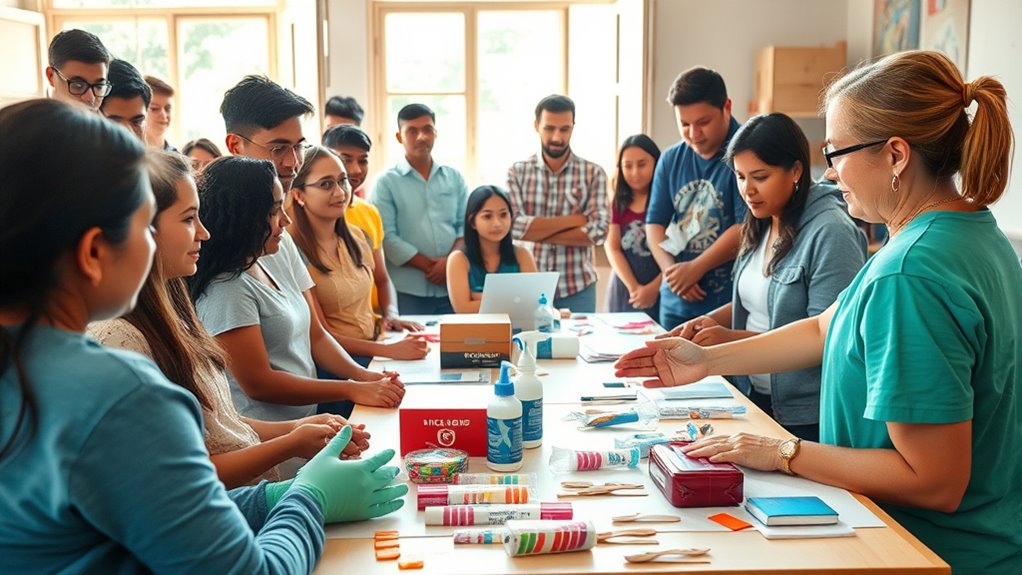To improve your basic first aid skills affordably, start by using free online tutorials and courses that cover essential techniques like CPR and wound care. Practice with household items, such as cloths and tape, to simulate real emergencies and build confidence through hands-on experience. You can also join local workshops or community events that often offer low-cost or free training. Keep exploring these options to boost your preparedness and comfort in emergency situations.
Key Takeaways
- Utilize free online tutorials and courses to learn essential first aid skills at your own pace.
- Practice emergency scenarios using household items to reinforce practical skills affordably.
- Join local community workshops or training sessions that are often free or low-cost.
- Combine digital resources with DIY simulations to maximize hands-on practice without expenses.
- Engage in self-directed learning and community events to stay updated and build confidence in first aid.
Utilize Free Online Resources and Tutorials

Taking advantage of free online resources and tutorials is one of the most cost-effective ways to boost your basic first aid skills. Video tutorials offer step-by-step demonstrations that help you learn essential techniques like wound care, CPR, and choking relief at your own pace. These videos are accessible anytime, making practice flexible and convenient. Additionally, numerous free online courses cover a wide range of first aid topics, granting you extensive knowledge without spending money. By engaging with these resources, you can build confidence and stay prepared for emergencies without the need for in-person classes or expensive training sessions. Leveraging free online tutorials and courses is an efficient way to enhance your skills while keeping costs low. Incorporating essential first aid skills into your routine can further improve your readiness for unexpected situations.
Practice With Household Items and DIY Kits

Practicing first aid techniques with household items and DIY kits is an affordable way to build confidence and reinforce your skills. DIY simulation allows you to recreate common emergency scenarios using everyday objects, making learning practical and engaging. For instance, you can simulate a wound by using a clean cloth and some tape or practice splinting a broken finger with sticks and bandages from your home. Household improvisation encourages creative problem-solving and helps you familiarize yourself with real-life situations without additional costs. Incorporating mindfulness techniques during practice can enhance your focus and reduce stress, making your training more effective. This hands-on approach boosts your comfort level and competence, ensuring you’re better prepared during an actual emergency. Regular practice with household items makes first aid techniques second nature, all while keeping your budget intact.
Join Community Workshops and Local Training Sessions

Participating in community workshops and local training sessions offers an affordable way to enhance your first aid skills beyond practice at home. These events often focus on emergency preparedness and safety drills, giving you hands-on experience that boosts confidence and competence. Local organizations frequently host free or low-cost classes, making them accessible for everyone. Attending these sessions helps you learn current techniques and understand how to respond effectively in various emergencies. Plus, you connect with others who share your goal of being prepared. To maximize your learning, look for workshops that cover topics relevant to your community’s needs. Here’s a quick comparison:
| Benefit | Description |
|---|---|
| Cost-effective | Usually free or low-cost |
| Practical skills | Hands-on emergency preparedness |
| Community engagement | Build local safety networks |
| Updated knowledge | Learn current first aid techniques |
| Confidence boost | Practice real-life scenarios |
Frequently Asked Questions
How Often Should I Review My First Aid Skills?
You should review your first aid skills at least once every two years to maintain skill retention strategies effectively. Doing a regular first aid refresher, such as quick practice sessions or watching instructional videos, helps reinforce your knowledge. Keeping your skills sharp guarantees you’re prepared in emergencies. Set reminders to revisit your training, and consider participating in affordable community workshops or online courses for ongoing practice and confidence.
Are There Mobile Apps for Quick First Aid Guidance?
You’ll find plenty of mobile apps for quick first aid guidance, and reviews help you pick the best one. Some emergency app features include step-by-step instructions, videos, and alerts. While no app replaces professional training, they’re handy for immediate help. Don’t worry about complexity; most are user-friendly, so you can access crucial info swiftly during an emergency, enhancing your confidence and safety when it matters most.
Can I Legally Perform First Aid Without Certification?
You can perform first aid without certification, but legal considerations vary by location. Generally, you’re protected under good Samaritan laws if you act in good faith and within your skill level. However, certification requirements might be mandatory for certain professions or situations. Always check local laws before providing aid, and remember that your primary goal is to help safely without causing harm.
What Are the Most Common First Aid Mistakes to Avoid?
Don’t rush CPR techniques or overlook wound dressing, as these are common mistakes you want to avoid. You might think doing more is better, but improper CPR can cause harm. Similarly, skipping proper wound dressing can lead to infection. Stay calm, follow correct procedures, and focus on clear, confident actions. Practicing these basics ensures you provide effective first aid without risking further injury or complications.
How Do I Keep My First Aid Supplies Updated on a Budget?
To keep your first aid kits updated on a budget, regularly check expiration dates on supplies and replace only what’s needed. Use cost-effective updates by buying in bulk or during sales at pharmacies or discount stores. Keep a list of essential items to avoid unnecessary purchases, and consider DIY replacements for some supplies. This approach guarantees your first aid kits stay current without overspending, so you’re always prepared for emergencies.
Conclusion
By tapping into free online tutorials, practicing with household items, and joining local workshops, you turn basic first aid from a formidable task into a confident skill. Think of it as planting seeds—each small effort grows into a safety net for you and your loved ones. So, start today; the more you learn, the stronger your safety net becomes. Remember, knowledge is the best first aid—ready when you need it most.









